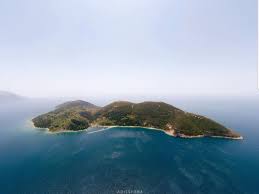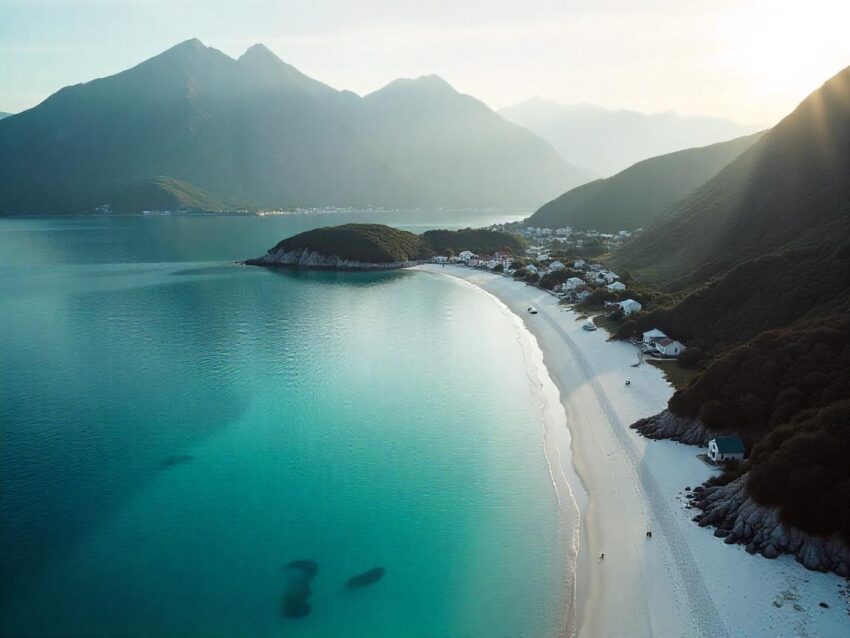Key Takeaways
- Sazan Island blends rich military history with untouched natural beauty, offering a unique experience in Albania.
- Geographically positioned at the strategic entrance of the Bay of Vlorë, it controls vital maritime routes [Wikipedia, “Sazan Island”](https://en.wikipedia.org/wiki/Sazan_Island).
- The island’s history spans Italian occupation, Soviet naval use, and Albanian military significance—each leaving a distinct mark.
- Its natural environment is a sanctuary for diverse marine and land species, protected within the Karaburun-Sazan National Marine Park.
- Visiting Sazan offers a unique adventure—exploring historic ruins, pristine landscapes, and vibrant marine life—though access is regulated.
Geographic Location and Description of Sazan Island
*Nestled at the entrance of the Bay of Vlorë in northern Strait of Otranto*,
Sazan Island exhibits a compelling blend of rugged terrain and strategic maritime importance. It lies approximately 15 kilometers from the Karaburun Peninsula, the vital juncture where the Adriatic meets the Ionian Sea. This positioning made it a key maritime guard post, controlling shipping routes and naval movements.
Covering around 5.7 square kilometers, the island’s landscape is dominated by rocky cliffs and limited vegetation—testament to its resilient nature and Mediterranean climate. Summers are warm and dry, winters mild and wet, creating a year-round environment conducive to exploration and study [Wikipedia, “Sazan Island”](https://en.wikipedia.org/wiki/Sazan_Island).
For a deeper understanding, tools like Google Earth reveal detailed satellite images and terrain features, offering virtual access to its exact coordinates and interactions with the surrounding sea. External geographic resources, such as Albanian Ministry of Environment and Tourism sites, further illustrate its strategic and natural significance [Google Earth](https://earth.google.com/).
Historical Background of Sazan Island
*This island’s history reflects a tapestry of military strategic importance and shifting sovereignties.* It was under Italian control from 1920 to 1947, leaving behind fortifications and infrastructure that still mark the landscape [National Archives of Albania]. These structures hint at its vital role during WWII and subsequent periods.
During the Cold War, Sazan transformed into a Soviet naval base, hosting bunkers and sophisticated military installations from the 1950s until 1961. This phase underscored its significance as a strategic maritime hub. After Soviet withdrawal, Albania repurposed the base for its own military use until political changes in the 1990s left the island abandoned, with nature reclaiming what was once controlled by military might [Balkan history journals].
Today, remnants of these eras tell fascinating stories. Visitors can explore such military ruins, which sit amidst natural beauty, symbolizing the island’s layered history—from Italian occupation and Cold War tactics to efforts at preservation and eventual tourism development [Karaburun-Sazan National Marine Park Management Plan].
Natural Environment and Wildlife on Sazan Island
*A haven within the Karaburun-Sazan National Marine Park*, the island boasts diverse ecosystems—marine and terrestrial—that shelter many protected species. Its vibrant underwater world teems with fish like wrasse and moray eels, making it ideal for diving and marine research [Karaburun-Sazan National Marine Park official website].
On land, aromatic herbs such as sage, thyme, and shrubs thrive, creating a fragrant landscape that supports local fauna. Moreover, the island provides critical nesting sites for endangered birds, including the Eleonora’s falcon—spotting such species adds a special dimension to visits [Birdlife International].
Preserving this biodiversity is a priority. Organizations like ASPBM and IUCN work to ensure ecological balance, emphasizing the fragile yet resilient environments of Sazan Island. Scientific studies continue to uncover its rich biological tapestry, promising further understanding and conservation [IUCN Red List].
Visiting Sazan Island: A Traveler’s Guide
*Adventure awaits those who venture to this historically and naturally rich island.* Access is mainly via boat tours departing from Vlorë. Guided trips often include exploration of military ruins, hiking trails, and snorkeling spots, offering a comprehensive experience of Sazan’s layered heritage and landscapes.
Since parts of the island remain restricted for safety reasons—due to old military structures—obtaining a permit through local tour operators or authorities is essential. Tours typically last half a day, combining history, nature, and outdoor activities. Timing visits during spring or summer enhances the experience with warm weather and longer daylight hours [Visit Albania].
Preparation is key: bring water, sun protection, and suitable footwear. Check with tour providers about access and safety advisories to ensure a smooth journey. The thrill of walking through historic ruins against the backdrop of untouched landscapes makes every trip memorable [Travel forums].
Current Status and Preservation Efforts on Sazan Island
*Today, the island stands as a symbol of sustainable conservation and potential tourism growth.* Managed within the framework of the Karaburun-Sazan National Marine Park, ongoing initiatives focus on protecting its military relics and natural habitats while promoting eco-friendly visits. The Ministry of Environment and Tourism coordinates projects to ensure minimal environmental impact [Albanian Ministry of Environment and Tourism].
Efforts include regulating tourist access, supporting educational programs, and involving international organizations like UNESCO to safeguard its UNESCO potential sites. These measures aim to strike a balance between preservation and development, fostering responsible tourism that benefits local communities and the environment alike [UNESCO].
Future plans emphasize sustainable infrastructure, awareness campaigns, and collaborations with conservation groups. Such initiatives aim to keep Sazan Island pristine, ensuring long-term ecological and historical integrity—an inspiring model for responsible tourism in sensitive areas [Karaburun-Sazan National Marine Park Management Plan].
*Preparing ahead makes the difference between a good trip and an unforgettable one.* Visitors should secure necessary permits via tour operators or relevant authorities. Given limited facilities, packing essentials such as water, sunscreen, and sturdy footwear is advisable.
Exploring ruins requires caution—many structures are aging and may be unsafe. Guided tours help navigate these sites safely while enriching your understanding of the island’s history. Staying on designated paths minimizes ecological impact and ensures safety [Tour operators].
Stay updated with recent travel advisories and access rules through online forums and Albanian travel websites. Respect local regulations and the island’s protected status—responsible behavior preserves Sazan’s beauty for future generations.
Conclusion: Embarking on a Journey Through Sazan Island
Sazan Island stands as a captivating blend of history, nature, and strategic significance, offering explorers a pathway through Albania’s multifaceted heritage. From ancient military fortifications to vibrant marine ecosystems, each element invites respectful curiosity and discovery.
As awareness and preservation efforts grow, responsible tourism becomes essential—helping protect this unique sanctuary for future generations. Whether you’re drawn by its past, intrigued by its natural beauty, or seeking an adventure, Sazan Island promises an unforgettable journey into Albania’s hidden treasures.





